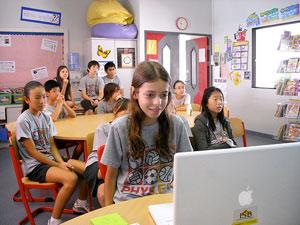Teaching to children, not the classroom
(Image by superkimbo in BKK (cc:by-nc-sa))
This story was originally covered by PRI’s Here & Now. For more, listen to the audio above.
Most classrooms haven’t changed very much in recent decades. They often involve one teacher lecturing to students and reading from books. “Teachers generally work on a mass-production model,” Ta Nehisi Coates wrote recently for the Atlantic. “If 30 kids are in the class, the goal is to find a method that will allow the highest percentage of them to succeed.”
When a few kids fall behind in class, or other kids feel held back, there’s not a lot that most teachers can do. According to Coates, “given the variables that individual students bring to the class, a handful of kids will inevitably be shortchanged.”
One of those children was Coates himself, who is now a senior editor for The Atlantic. He started fantasizing about dropping out of school around the fourth grade, Coates told PRI’s Here and Now. “I think I had a basic inability to sit still and pay attention.” At the same time, his parents were intent on him getting a good education. He wrote, “For black boys,” like Coates, “there seemed to be only two roads — college or jail — and my parents would go to any ends to ensure that I took the former.”
Recently, Coates started to wonder if a program like School of One could have helped him when he was a child. The after-school math program, run out of the South Bronx middle school I.S. 339, is an attempt to personalize education, making children the focus of education, rather than the classroom. The school is almost entirely African-American and Latino, and most of the students are poor enough to be eligible for food stamps. The Schol Coates explained the program:
First, the student and his parents and teachers are surveyed about his classroom habits. Then the student takes a diagnostic test to see how well he understands basic math. Those data are then sent to the New York Department of Education’s headquarters in Lower Manhattan, where School of One’s algorithm produces a tentative lesson plan. That lesson plan is then e-mailed to the student’s teachers, who revise it as they see fit. At the end of every day, the student takes another short diagnostic, which is used to create another tentative lesson plan that appears in the teachers’ inboxes by eight o’clock that evening.
The idea is to teach each child in the way that he or she would best receive the information. On any given day in the Student of One program, some students could be studying alone and some in groups. Some could use dry erase boards, while others use the internet. “Some students can sit for a long time in a classroom, and then some can’t,” Blair Heiser, School of One’s math coach, told Coates. “It’s not necessarily a learning disability; they might need [to get] the information in a different way.”
Though Coates eventually graduated from high school, it was only after much support (and pestering) from his parents. An innovative program like the School of One, though, may have been able to turn his academic career around. He still wonders “if all I had ever really needed was the equivalent of a warm hug from a cold algorithm.”
The program has been successful enough that it will replace I.S. 339’s math program next year. There are still plenty of unknowns, though, about how effective the program will function on a larger scale. “So far, it’s been effective,” Coates told Here and Now. “But I’m trying not to oversell this, because we just don’t know.”
“Here and Now” is an essential midday news magazine for those who want the latest news and expanded conversation on today’s hot-button topics: public affairs, foreign policy,science and technology, the arts and more. More “Here and Now”
Every day, reporters and producers at The World are hard at work bringing you human-centered news from across the globe. But we can’t do it without you. We need your support to ensure we can continue this work for another year.
Make a gift today, and you’ll help us unlock a matching gift of $67,000!
